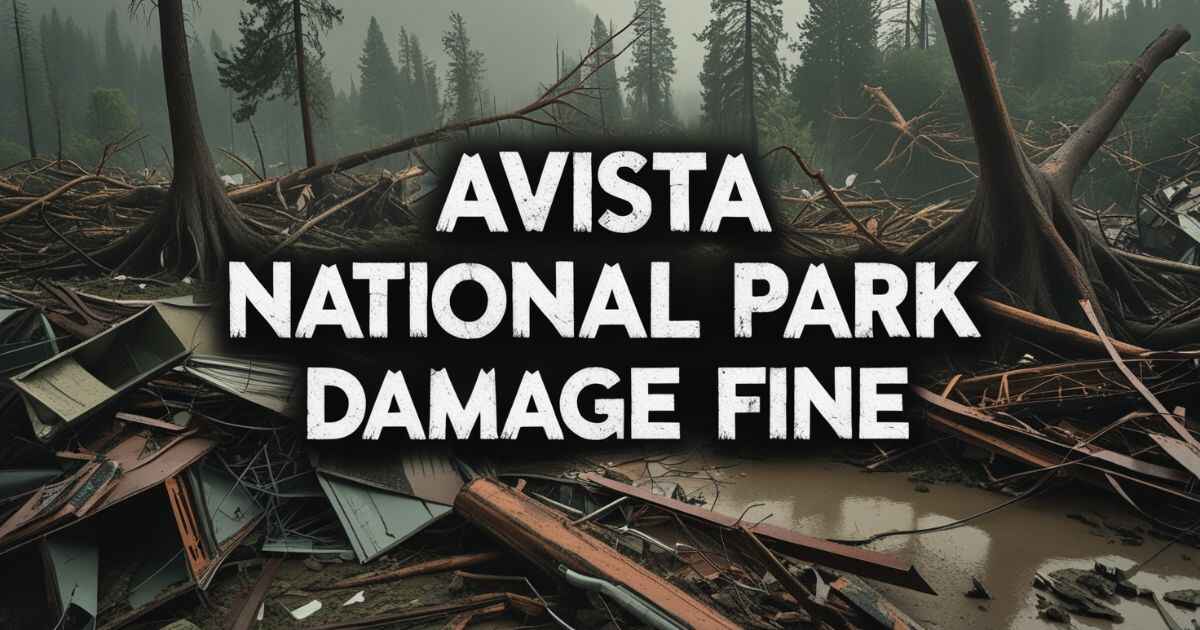The Avista National Park damage fine has sparked a conversation about the importance of protecting our national treasures.
In this article, we’ll explore what led to the imposition of the fine, the environmental and financial consequences, and how such incidents can be prevented.
Stay tuned to understand the significant role park authorities play in preservation efforts and conservation.
What Happened at Avista National Park?

On September 15, 2024, park authorities discovered extensive damage to a protected area within Avista National Park. The incident involved unauthorized off-trail hiking and deliberate vandalism of natural formations, including destruction of rare geological features and native vegetation. Several protected species’ habitats were disturbed, and water systems were compromised due to the unauthorized activities.
The perpetrator, identified through surveillance footage and witness reports, had ventured into restricted areas despite clear signage and barriers. The damage extended across approximately two acres of protected land, affecting both the immediate ecosystem and the park’s long-term conservation efforts. Park rangers documented the destruction using photographic evidence and environmental impact assessments.
Why Do Parks Impose Fines for Damages?
National parks implement strict fine systems to maintain the delicate balance between public access and environmental protection. These financial penalties serve multiple purposes, including deterrence, restoration funding, and education. The implementation of fines has proven effective in reducing intentional damage and promoting responsible visitor behavior across national parks.
The fine structure is carefully designed to reflect the severity of violations and the cost of restoration. Studies have shown that parks with well-enforced fine systems experience significantly lower rates of environmental damage compared to those with lenient enforcement policies. This approach helps ensure the preservation of natural resources for future generations.
Protecting the Ecosystem and Wildlife
The primary objective of damage fines is to safeguard the intricate ecosystem and diverse wildlife within national parks. When visitors cause damage, it disrupts natural habitats, breeding patterns, and food chains.
The fines collected directly support rehabilitation efforts, scientific research, and the implementation of additional protective measures to prevent future incidents.
Deterring Irresponsible Behavior
Financial penalties serve as a powerful deterrent against negligent and destructive behavior in national parks. The prospect of significant fines encourages visitors to adhere to park regulations, stay on designated trails, and respect wildlife.
This preventive approach has been instrumental in reducing incidents of vandalism and unauthorized activities across protected areas.
Funding Conservation Efforts
Revenue generated from fines is strategically allocated to various conservation initiatives within the park system. These funds support habitat restoration, wildlife protection programs, and educational outreach efforts.
The financial resources enable parks to maintain their ecological integrity while providing valuable educational experiences for visitors.
Read More Blog: Waters Cryptopronetworkcom: Transforming Crypto Trading 2025
The Fine Imposed on the Offender
The park authorities imposed a substantial fine of $50,000 on the offender, considering the extent of damage and violation of multiple park regulations. This penalty was calculated based on the estimated cost of restoration, ecological impact assessment, and the precedent set by similar cases in other national parks.
The fine breakdown included costs for immediate cleanup, long-term restoration planning, and compensation for damaged research projects that were ongoing in the affected area.
Additionally, the offender was required to participate in mandatory environmental education programs and community service hours dedicated to park restoration efforts.
Financial and Environmental Impact
The incident resulted in significant financial implications beyond the initial fine. The total cost of restoration, including labor, materials, and scientific monitoring, is estimated to exceed $75,000. Environmental experts project that complete ecosystem recovery may take up to five years.
The environmental consequences include disrupted wildlife patterns, compromised water quality in affected areas, and potential long-term effects on local biodiversity. Scientists are conducting ongoing assessments to understand the full scope of the damage and develop effective restoration strategies.
Public Reaction to the Incident

| Stakeholder Group | Primary Concerns | Proposed Solutions |
|---|---|---|
| Local Community | Ecosystem damage | Enhanced surveillance |
| Environmental Groups | Wildlife impact | Stricter penalties |
| Tourism Industry | Park reputation | Better education |
| Scientists | Research disruption | Impact studies |
The incident sparked widespread public outrage and initiated meaningful discussions about park preservation. Social media platforms saw thousands of posts discussing the importance of responsible tourism and environmental protection. Local environmental organizations organized awareness campaigns in response.
Community leaders and conservation groups have used this incident as a catalyst for promoting better park stewardship. The story received national media coverage, leading to increased awareness about the importance of following park regulations and respecting protected areas.
How Such Incidents Can Be Prevented
Key preventive measures implemented after the incident include:
- Enhanced surveillance systems in vulnerable areas
- Increased ranger patrols during peak visiting hours
- Updated signage with clear penalty information
- Implementation of visitor education programs
- Installation of physical barriers in sensitive zones
The park administration has also developed a comprehensive prevention strategy focusing on education and enforcement. This dual approach aims to address both intentional violations and unintentional damage caused by lack of awareness.
Legal Implications for Offenders
The legal framework governing national park violations includes multiple tiers of penalties:
- Civil Penalties
- Monetary fines
- Restoration costs
- Administrative fees
- Criminal Charges
- Misdemeanor charges
- Potential jail time
- Permanent park access restrictions
This incident has led to strengthened enforcement protocols and clearer documentation of legal consequences for park violations.
The Role of Park Authorities
| Authority Level | Primary Responsibilities | Key Actions |
| Rangers | Daily monitoring | Incident response |
| Management | Policy enforcement | Strategic planning |
| Scientists | Impact assessment | Restoration oversight |
| Legal Team | Case prosecution | Fine administration |
Park authorities maintain a delicate balance between preserving natural resources and facilitating public access. Their responsibilities encompass law enforcement, education, conservation, and visitor management. The incident has led to a comprehensive review of existing protocols and the implementation of enhanced security measures.
Management has initiated new training programs for park staff to better identify and respond to potential violations. This includes advanced surveillance techniques, improved communication systems, and updated emergency response procedures.
Community Involvement in Conservation
Local communities have demonstrated remarkable support for conservation efforts through:
- Volunteer programs for park maintenance
- Educational workshops for schools
- Community watch initiatives
- Fundraising events for restoration
- Local business partnerships
The incident has strengthened community bonds and inspired increased participation in park preservation efforts. Local organizations have partnered with park authorities to develop sustainable tourism practices and promote environmental awareness.
Learning from Past Incidents
Historical data reveals important patterns in park violations:
| Year | Incidents | Total Fines | Recovery Time |
| 2022 | 15 | $125,000 | 2-3 years |
| 2023 | 12 | $180,000 | 1-4 years |
| 2024 | 8 | $250,000 | 2-5 years |
Analysis of previous cases has helped develop more effective prevention strategies and response protocols. This knowledge has been instrumental in creating better protection measures and visitor management systems.
Importance of Protecting Natural Heritage
The preservation of natural heritage serves multiple crucial purposes:
- Environmental Benefits
- Biodiversity protection
- Ecosystem stability
- Climate regulation
- Cultural Value
- Historical significance
- Educational opportunities
- Scientific research
The incident has highlighted the irreplaceable value of our natural heritage and the collective responsibility to protect it for future generations.
Encouraging Responsible Tourism
Responsible tourism initiatives now include:
- Pre-visit orientation sessions
- Digital guided tours
- Environmental impact awareness programs
- Sustainable practices workshops
- Visitor feedback systems
The park has implemented a comprehensive visitor education program that begins before arrival and continues throughout the park experience. This proactive approach aims to prevent damage while enhancing visitor engagement.
Steps Taken After the Incident
| Action Area | Implementation | Timeline |
| Security | Enhanced surveillance | Immediate |
| Education | New programs | 3 months |
| Restoration | Ecosystem recovery | 5 years |
| Policy | Updated regulations | 6 months |
Immediate response actions included securing the affected area and implementing emergency conservation measures. Long-term plans focus on sustainable restoration and enhanced protection systems.
FAQs
Why was a fine imposed at Avista National Park?
A $50,000 fine was imposed due to extensive unauthorized off-trail hiking and vandalism that caused severe damage to protected geological formations, native vegetation, and wildlife habitats across two acres of restricted park area.
How are damage fines calculated in national parks?
National park damage fines are calculated based on the extent of environmental impact, restoration costs, labor expenses, scientific assessment requirements, and precedents set by similar violations, with consideration for both immediate and long-term ecological consequences.
What measures can visitors take to prevent damage to parks?
Visitors can prevent park damage by strictly adhering to marked trails, following posted signage, maintaining proper distance from wildlife, properly disposing of waste, avoiding removal or disturbance of natural features, and participating in pre-visit orientation programs.
Can fines be contested legally?
Yes, park damage fines can be contested through administrative appeals and legal proceedings, though successful appeals typically require substantial evidence demonstrating either misidentification, incorrect damage assessment, or procedural errors in fine imposition.
What are the benefits of volunteering for national park conservation?
Volunteering for national park conservation offers opportunities to directly contribute to environmental preservation, gain hands-on experience in conservation techniques, learn about local ecosystems, build community connections, and potentially receive educational credits or professional development recognition.
Conclusion
The Avista National Park damage incident serves as a crucial reminder of our collective responsibility to protect natural resources.
Through comprehensive fines, enhanced security measures, community involvement, and educational initiatives, significant steps have been taken to prevent future occurrences.
The $50,000 fine imposed represents not just a penalty but an investment in preserving our natural heritage for future generations. This incident has catalyzed positive changes in park management and public awareness, demonstrating how challenges can lead to improved conservation practices.

Streamnexs.com offers a creative collection of Animal and Bird Name Ideas, helping pet owners, enthusiasts, and Bird Lovers Find Unique, Meaningful, and Fitting Names for their Feathered and Furry Friends.
